Donnelly Canyon and the Supercrack Buttress
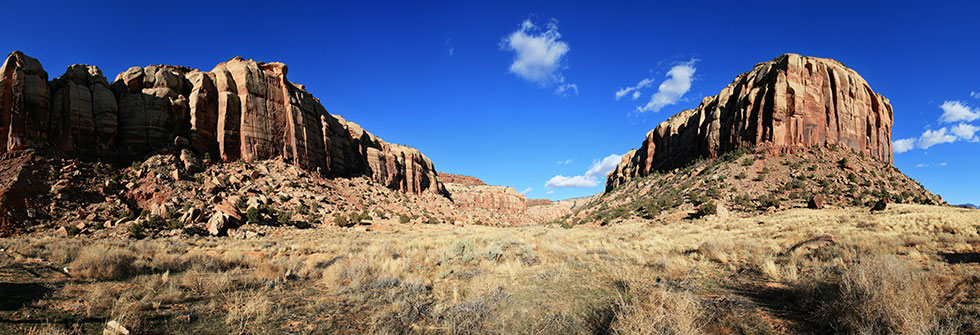 |
Tom Grundy's Indian Creek 2011 Travels Page
Indian Creek is a legend in the climbing world. If you look at the magazines and catalogs, it is hard to avoid images of endless red Wingate sandstone cliffs with vertical splitter cracks. In fact a nice clean crack is often described as like "Indian Creek" and many of the cracks there would be the 5 star must-do routes anywhere else. Include a sunny desert climate and free camping and it isn't hard to see why it is such a popular destination.
Stephanie starts up "Incredible Hand Crack"
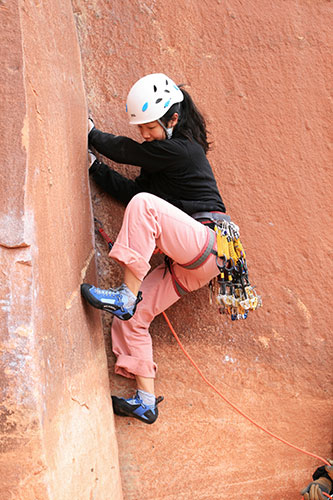 |
Lots of gear is nice for the creek
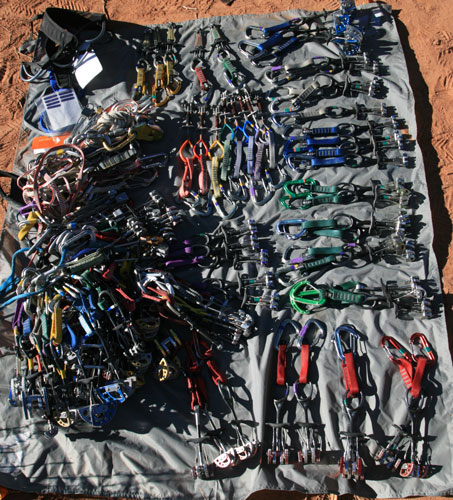 |
Stacy mentioned she was going to be heading to Indian Creek for spring break, and I decided that was a good enough excuse to head there too. I camped nearly there on Sat night on Feb 25th. It was cold and the forecast threatened snow for Sunday. That morning I headed down to the monstrous new paved parking lot by Donnelly Canyon. I walked around picking up trash scraps and read waiting to meet up with Stacy and Stephanie. Then we headed up to the Supercrack butress to get started. It was still pretty chilly, but not completely unclimbable despite the occasional snow flakes. We even got a little bit of sun. We started out with the "Incredible Hand Crack". This one got a bit wide for the others and I ended up finishing up the lead and they top-roped it. Then I tried to lead "fingers in a light socket" That was a mistake. I fell and hung a lot and thrutched my way up the "exciting finish". Stephanie did a bit better on top rope. 2 climbs was plenty to get us started. Back at camp in the Superbowl area we had a most excellent and large dinner. It was cold but we were well bundled up. The stars were nice, but it was cold enough so that spilled water turned to slush on the picnic table while we sat there, so it wasn't long before we retreated to our sleeping bags.
Stacy Heads up "Dirt Cheap"
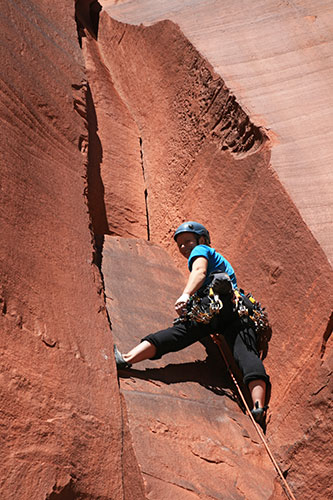 |
Stacy clips gear on "Scarface"
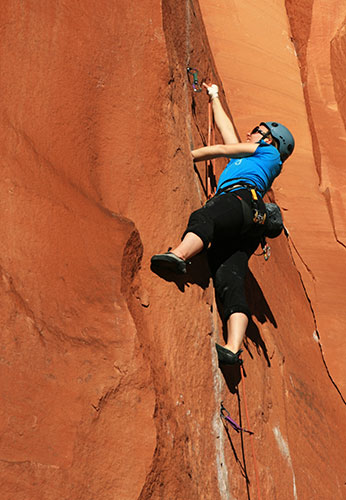 |
As the days passed, the weather improved to the point that we were able to climb in shorts and t-shirts in the sun. Still, it got cold at night and we weren't starting very early because it was cold in the morning. Between relaxed starts, being out of shape, timid, weak, a party of 3, and just slow, we usually managed to get in 2 or 3 of the shorter climbs each day. This still managed to make us sore and ready to quit by the time it was getting cold and dark. We weren't just getting on easy routes though (although there really aren't many easy routes at the creek). For every 5.9 like "Chocolate Corner", there was a 5.11 or 5.12 like "Sweden Ringle" to humble us. We all took turns leading, sometimes on the same climb. At other times, once the top rope was set up we were content to focus on trying to do the moves without messing with the gear.
little Stephanie carried everything
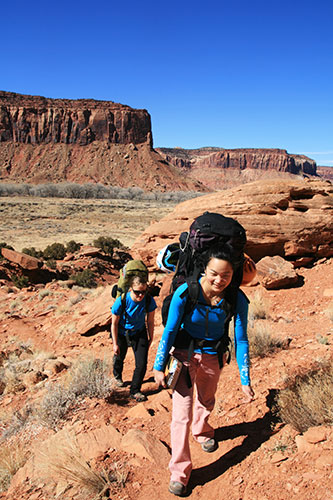 |
I head up "Chocolate Corner"
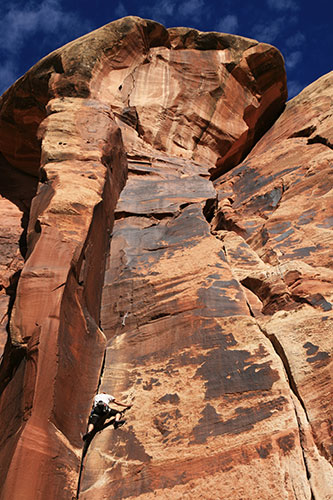 |
We all had reasons why we weren't cranking at 100% here. I was coming off of 3 months without climbing (plus lots of indoors sitting and good food eating), Stacy hasn't done a whole lot of climbing or other exercise recently due to medical school (this trip was the on-purpose wake up call to get back into things), and Stephanie is a sport climber who has barely done any trad climbing - in fact she doubled her experience on this trip. Luckily the gear in Indian Creek is usually very straightforward and you are often only limited by how many pieces of a given size you have and how many you can carry. We had more than we were willing to carry usually, so as long as we picked the correct size from the ground (and ignored the guidebooks assertion that a 2.5 Friend was the same as a #2 camalot (it is a #1)), we were able to lead with relatively little fear (although we still took plenty of falls and hung or even aided a bit when necessary). [non climber explanaition - Cams are the generic name for a piece of equipment that goes into the crack with expandable cams that grip the edges to hold in the case the climber falls (or hangs on the gear) they come in various sizes and brands that can also be designated by the colors they are. Unfortunately they aren't all standardized. Camalots are made by Black Diamond, Friends by Wild Country, and so on].The women had been given the advice to ignore the "easier" 5.10 climbs that tended to be larger cracks and instead concentrate on the 5.11 and 5.12 climbs that tended to be tight hands or fingers. To some extent this was valid advice, although it was better to start out with a climb with a softer rating because it also had rest positions, footholds, and was shorter. In any case we got on a variety of climbs although tended towards the thin hands and shorter lines.
Stephanie in particular had been sandbagged on the difficulty of splitter vertical cracks. [splitter refers to the quality of the crack and cliff - in general it suggests that there is just a single straight crack in a flat cliff face (forcing you to climb the crack because there is little else] Her friends had given her many suggestions that were based partly on her hand size (small) and on how hard she sport climbed (hard). After one lap on "Scarface" she was threatening to sell her rack [all her climbing gear]and never try crack again. Then later looking at the pictures she wanted to head back to try it again. A high tolerance for pain and short selective memory are useful attributes when learning to crack climb. By the end of the week she had greatly improved her jamming techniques and starting to trust her jams and feet. We even managed to convince her to lead "Battle of the Bulge" a very tiring dihedral layback crack (or very thin hands jamming even for her) when we were too tired at the end.
With 3 people and 2 cameras we were able to get photos of a lot of the climbing. Unfortunately without stringing up ropes most of the images were from below the climber - the classic butt shot. Still we got some good ones, unfortunately (for me) many of the best were on Stephanie's camera, so it might take some work to post them here.
crack climbing can be tiring
 |
After 3 days of climbing we needed a break. We headed to Moab for internet, food, water, and recovery. We also went into Arches NP and walked out to delicate arch. Unfortunately the weather wasn't all that conducive to photography (blah light and skies). Still, it was fun to hike on the slickrock and take images.
rather distorted composite of Delicate Arch
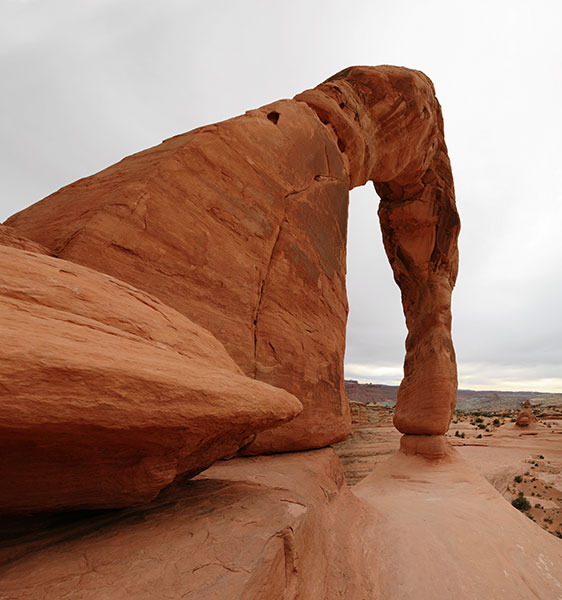 |
We went to the Battle of the Bulge area for the last 2 days and despite a bit of rain managed to get in 2 good climbing days with Sweden Ringle, Crack Attack, Railroad Crack, and Battle of the Bulge. Then Stephanie and Stacy had to leave and I was on my own.
Stephanie whipping on "Battle of the Bulge"
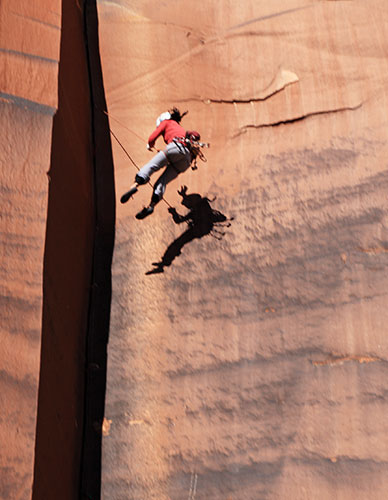 |
I was pretty tired from the previous 2 days of climbing so I planned to hike in the Needles district of Canyonlands National Park the next day. I didn't start as early as I would have liked, but I went big anyway. First I hiked out to Druid Arch and scrambled up on either side of it to take photos. Unfortunately once again the overcast skies and blah light was frustrating me. Then I headed back and cut over to Chessler park and through the Joint trail, then looped back through Chessler park and back to the car just after sunset. I figured that was about how long it would take me when I decided to go that route, but I didn't count on the light getting good and stopping to take a lot of pics. I jogged a bit to make up the time and as part of my plan to get back into shape. I think the total was a bit over 15 miles.
I look up at Druid Arch
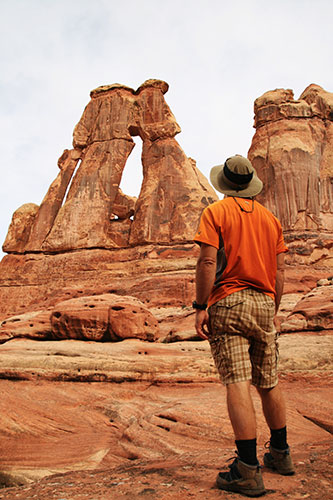 |
The joint trail
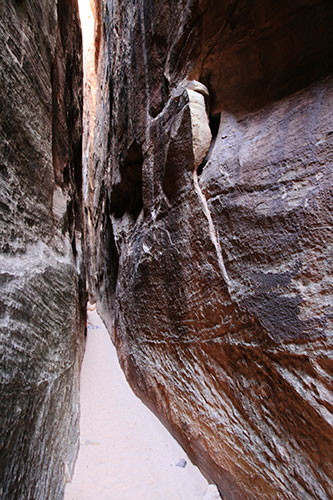 |
looking down Elephant Canyon from near Druid Arch (PS sky)
 |
I had seen Alf, who I had climbed with years ago in Wyoming, so I planned on joining up with his group the next day. Unfortunately with the crappy weather they decided to go hiking in Canyonlands. Luckily they opted for a different route so I joined them in hiking through Lost Canyon and Squaw Canyons. At around 9 or 10 miles it wasn't as long of a hike, but I was tired from the previous day's death march.
The next morning I moved camp over near Alf's setup and we went to Scarface. This time with no tape I managed to lead it clean (the tape on your hands protects them from abrasion but makes it harder to get them into tight cracks). Then on to toprope an adjacent climb before heading around the corner to toprope "Big Guy", an offwidth (or OW) [this is a crack that is wider than your fist and too small to actually get into (a chimney) - a notoriously difficult and painful size with various arcane and painful methods of stacking and wedging body parts to climb it]. As the size grew wider than hand stacks I started to struggle, but the suggestion to go both thumbs up on the hand-fist stack helped a lot. Soon I was able to shove my knee into the crack and from there it was just a matter of inching my way up. Luckily the climb ended just as it was starting to get too wide to wedge my knee/thigh securely. Armed with this taste of OW success we headed back around to try another wide crack. While Alf was leading that I took a TR burn [top rope climb] on a wide hand crack - not so nice for your knuckles. Then I got really worked on the OW - it was ok until it got too fat for hand-fist stacks, then I was just struggling - a full body workout.
Life continued on as the weather improved with 2 days of rather exhausting climbing followed by a day of rest, with a bit of mountain biking one day and a trip to Moab the next rest day. Alf favored long wide cracks at obscure cliffs with long approaches, so it was almost the opposite of the first week. Luckily we were joined by Doug who also was interested in the wide and had a lot of wide gear.
Alf leading "Big Daddy"
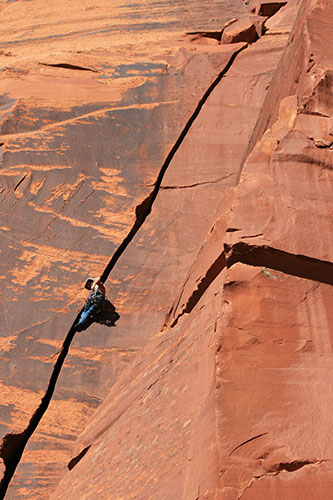 |
I gradually gained some strength and confidence on these wider cracks and by the end Alf was convincing me to lead some stuff that I most certainly wouldn't have at the beginning. SC Memorial was a long (50 some M (meters) of mostly #3 camalots (wide hands [too wide for easy hand jamming but too skinny to get your fist in - a relatively easy size but it tends to be a bit painful and tiring])). When it finally pinched down at the end to tight hands I could barely clip in the rope and had to rip the tape off one hand with my teeth to be able to get a jam good enough to hold me. It was desperate but I made it.
Alf took this pic of me on SC Memorial
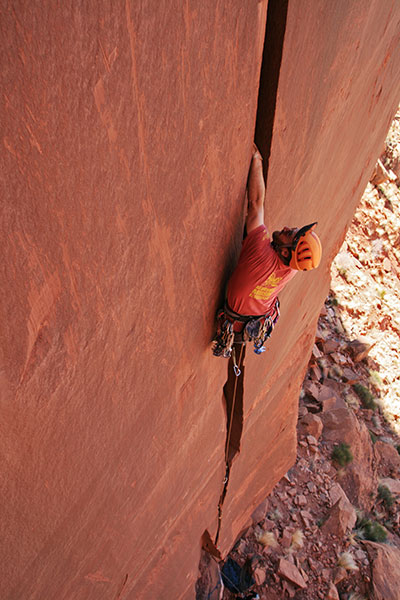 |
Doug leads SC Memorial
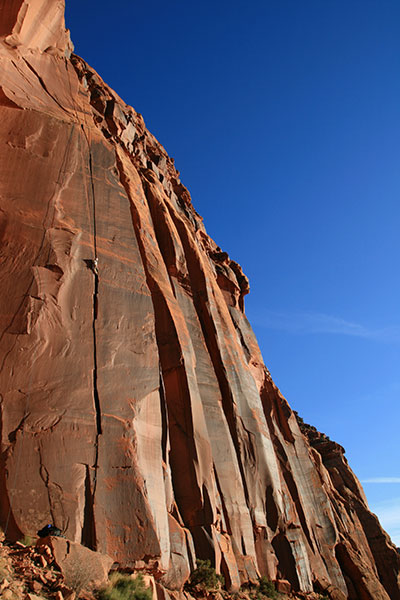 |
On the last day we hiked up to the "Cliffs of Insanity" from camp. There I led "Wiggins I", 34 M of mostly #4 camalots. Once again I got really worked and this time got a lot of forearm scrapes. That wasn't enough though and next we moved over to "Wiggin Out", which turned out to be my first true OW lead. This one went up to #5 Camalots although I was only able to get my knee in in 2 spots. Once again I could barely clip the rope by the end of the climb and I wore completely through one of my shoelaces. Then we headed around the corner just to "take a look" at "Lobotomy". Of course we had to get on it. Unfortunately we were pretty tired and even Alf was getting worked. By the time I got a TR run on it the sun was going down. This one got wider than stacked fists and was utterly exhausting. I stemmed past much of the business with the freedom of a toprope, but by the top I was completely wasted. Then we packed up and began the long walk down the talus slope and back to camp in the dark. Somehow I had neglected to return my headlamp to the climbing pack after the rest day, but luckily the 1/2 moon was enough to get us back down.
Alf starts up Wiggins I
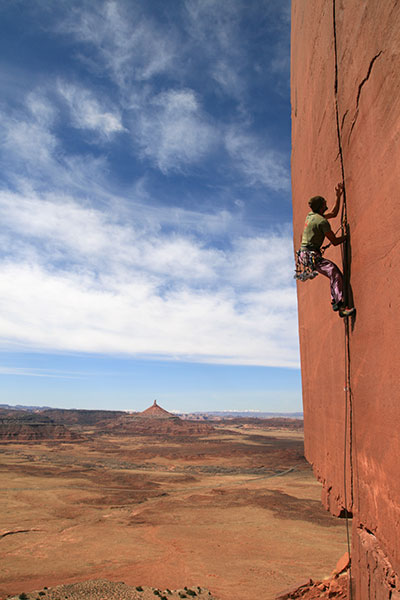 |
Alf at the top of Wiggins I
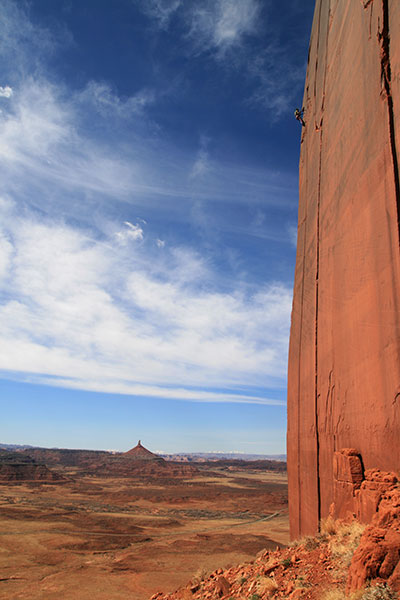 |
I lead up "Wiggins I" (Bob pic)
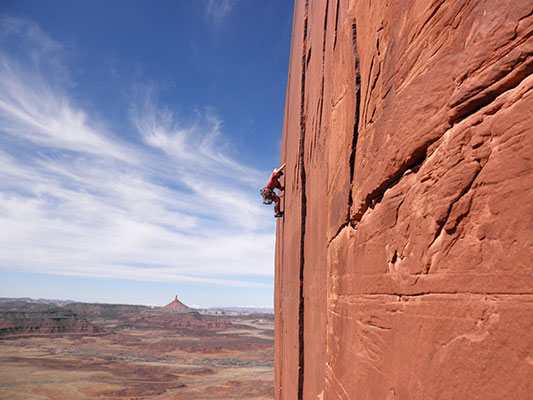 |
I plan my stacks while Alf pulls the rope on "Wiggin out" (Bob pic)
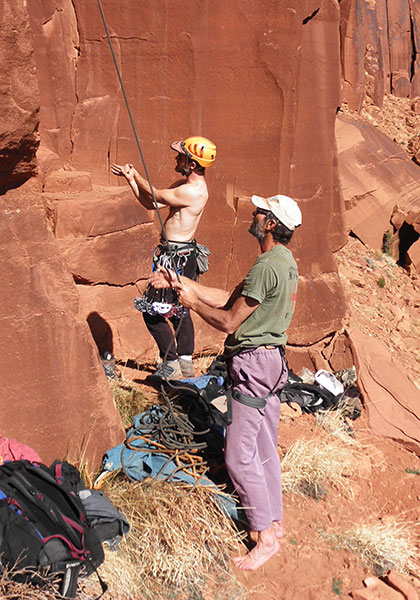 |
Alf in the thick of Lobotomy
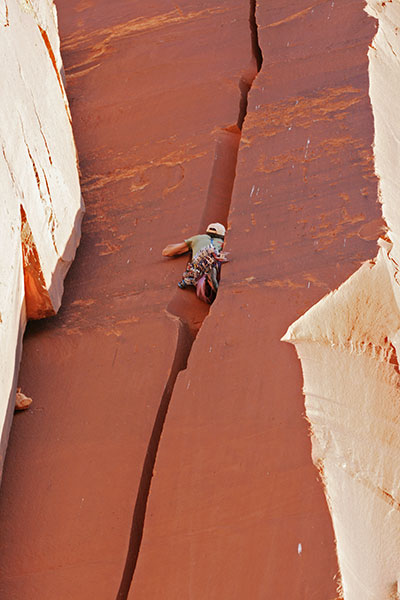 |
modern shower system - place in cab of truck to warm up.
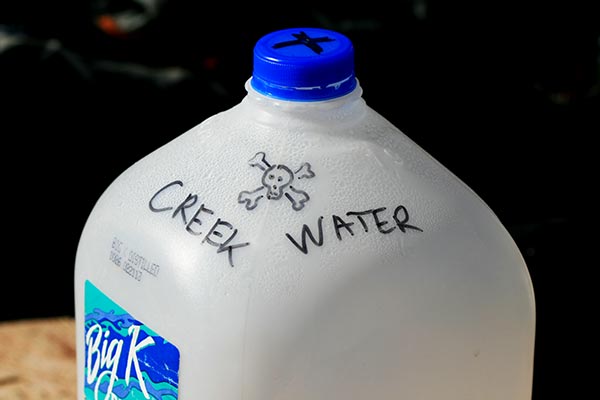 |
I figured I needed at least 3 days to recover, so I decided to head back to Flagstaff. Before I left I hiked up to a cliff dwelling to check it out and take pictures. I felt a bit like Indiana Jones, except there were no rolling boulders or golden statues. There was one 3 story tower which was impressive even if the stories were only about 4 feet tall. There were also some pictographs and collapsed buildings and a few potsherds and other artifacts.
Cliff Dwelling
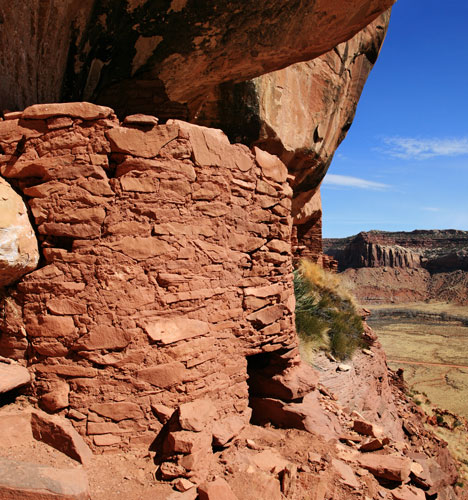 |
Cliff Dwelling tower
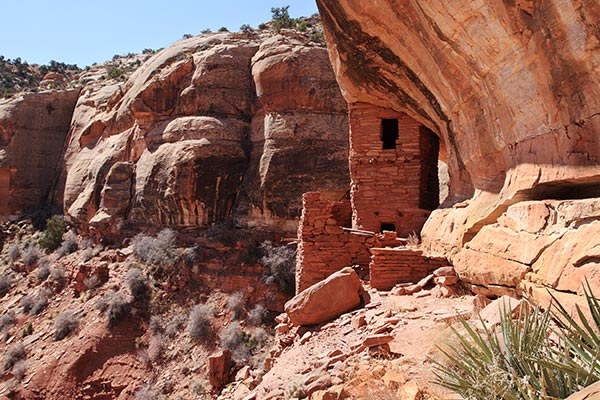 |
interior of Cliff Dwelling tower room
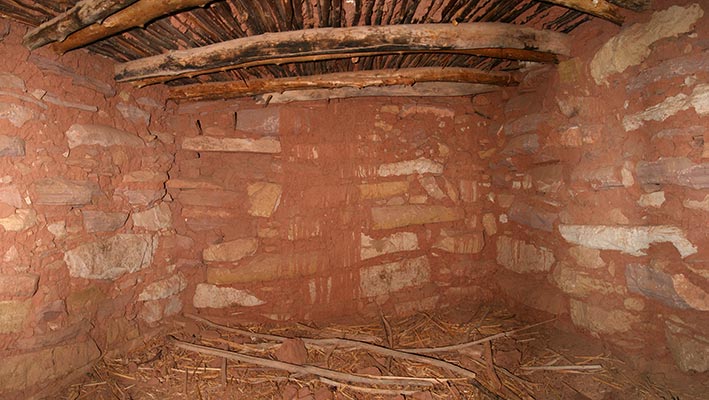 |
Newspaper Rock Petroglyphs
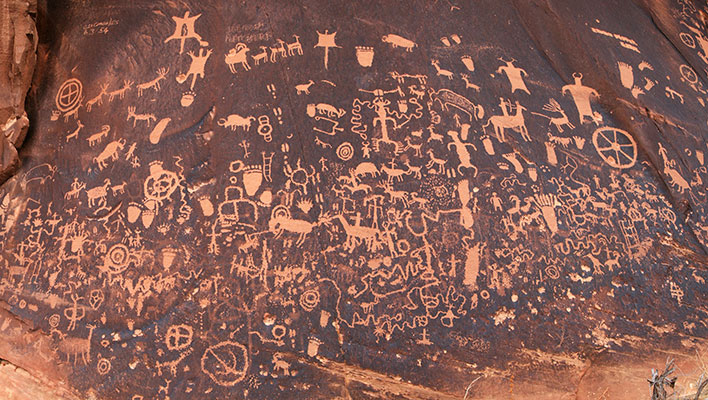 |
view from the beach past the North Six Shooter and the Needles of Canyonlands
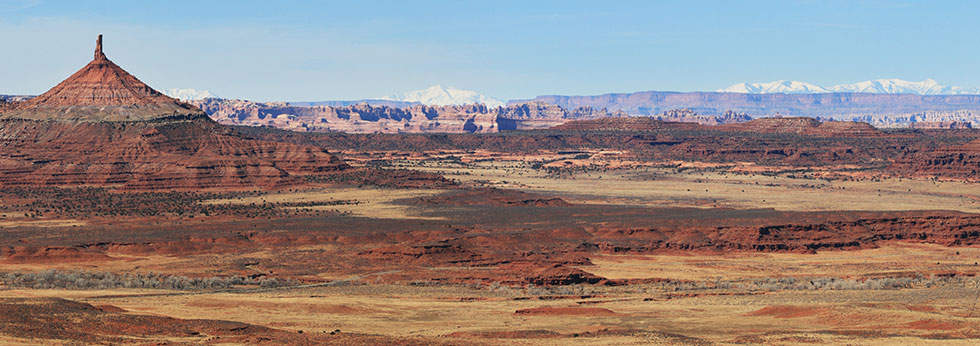 |
The drive back was pretty uneventful, but it does seem that it always clouds up when I pass through monument valley during the day.
My page on a trip here in 2007
That's all for now, although I hope to get a few more pics up eventually.
sunrise from the Superbowl camp
 |




























